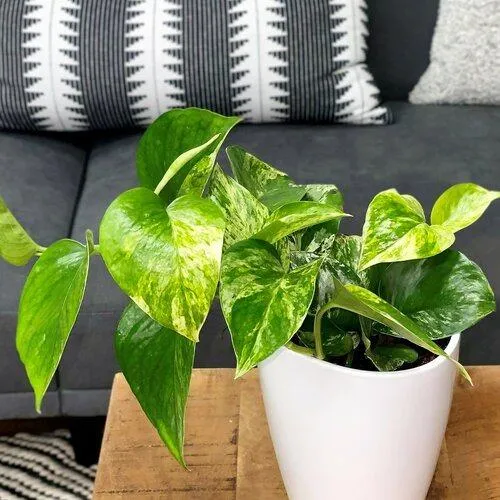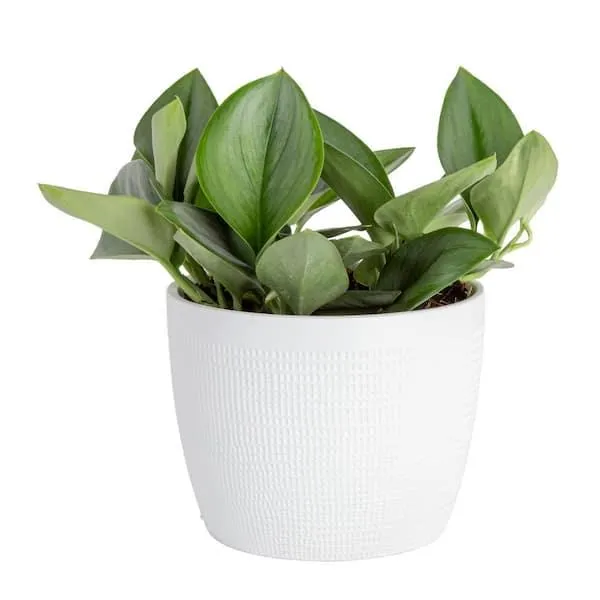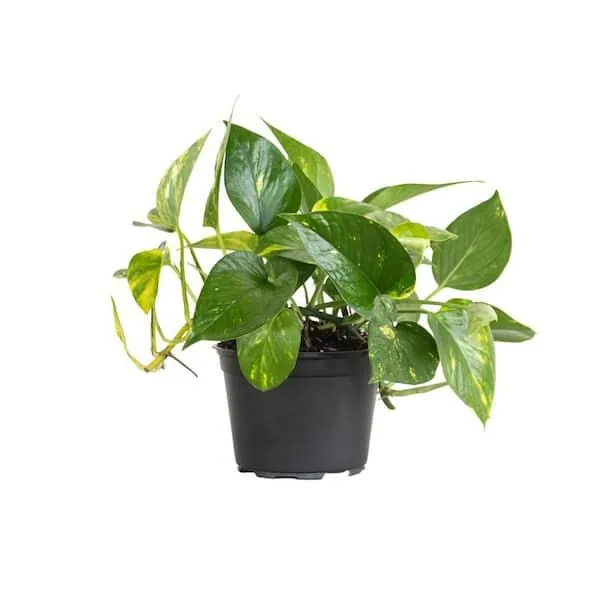Your Guide to the Most Popular Vining Houseplants
If you’re looking to add some vertical interest to your home, vining houseplants are a great option. Their trailing or climbing growth habits allow them to spread out and cover surfaces like walls, poles, or hanging baskets. In this article, I’ll discuss some of the most common and easy-to-grow vine varieties suitable for indoor conditions.
Pothos or Devil’s Ivy (Epipremnum aureum)
Pothos is probably the easiest vining plant to care for. From my experience, it’s incredibly durable and tolerant of low light. The heart-shaped green leaves are variegated with creamy white or yellow splashes. Pothos grows rapidly using its aerial roots to climb or trail wherever it finds support. You can train it up a moss pole or let it cascade down from a hanging basket.
Water when the top inch of soil dries out and feed monthly in the growing season. Pothos thrives on neglect! It removes toxins like formaldehyde from the air, making it a great choice for busy homeowners or offices. Just cut off sections to propagate more plants—no green thumb required. Despite its hardiness, pothos has an elegant tropical appearance that instantly livens up any room. For a low-effort option that’s nearly impossible to kill, pothos is your vine.
English Ivy (Hedera helix)
English ivy lends a woodland charm with its dark evergreen leaves. It closely resembles the ivy seen climbing buildings in many parts of the world. The mature foliage has 3-5 finely cut lobes which emerge darker green and become leathery over time. Ivy works well allowed to scramble freely along the ground, up trees or structures.
English ivy tolerates low light and thrives outdoors year-round in temperate zones. However, some varieties have gorgeous cream or gold variegated leaves perfect for indoor displays. Pot up ivy in cactus soil with added perlite or bark and water just enough to keep the soil slightly moist. It’s very hardy but avoid overwatering, which may cause foliage to yellow and drop. With patience, English ivy can reach enormous dimensions!

Golden Pothos (Epipremnum aureum ‘Marble Queen’)
A stunning variegated cousin of common pothos, ‘Marble Queen’ golden pothos boasts bright golden yellow variegation that completely covers the leaves. The vivid contrast pops whether suspended in a hanging planter or trained along a moss pole. Golden pothos has all the low-maintenance traits of regular pothos but gives an even more striking decorative element.
From my experience, golden pothos seems to grow a bit more slowly compared to the solid green variety. However, it enjoys the same care—letting the soil dry between waterings and occasional food. With its bright shine, golden pothos is ideal for drawing attention to your plant arrangements. It adds an elegant splash of color in any room and remains as resilient as a classic pothos.
Swedish Ivy (Plectranthus verticillaster)
If you want the lush foliage of English ivy with brighter variegation, Swedish ivy could be your winning choice. Native to Southern Africa, it features thick velvety leaves variegated in combinations of blue-green, creamy white, and yellow.Swedish ivy grows more slowly than other trailing houseplants but has an almost sculptural quality.
Over time, it develops long arching stems that will cascade elegantly. In my experience, Swedish ivy prefers moderate soil moisture and benefits from resting periods with dry soil in winter. Give it decent light and occasional fertilizer while allowing top growth to trail freely. Its jewel-toned leaves will reward you with vibrant decoration for tabletops, hanging baskets or walls.
Heartleaf Philodendron (Philodendron hederaceum)
With its heart or kidney shaped leaves, philodendron lends a lush tropical look. With veins of silvery-green contrasting the deep foliage, it brings nature indoors. Several cultivars exist but the classic heartleaf philodendron displays trailing stems perfect for training up a moss pole or allowing to spill over the sides of a hanging pot.

In my experience, philodendron tolerates low and indirect light very well. Keep the soil consistently moist but not soggy, and feed every few weeks for best growth. It can climb to over 6 feet given space! Consider placing a pole initially for the vines to latch onto. Heartleaf philodendron forms thick leathery roots that allow it to climb high with its tendrils, producing an impressive display that lasts for years.
From my experience, one tricky part of philodendron care is avoiding overwatering, which may cause yellowing leaves. Overall though, it remains quite hardy and forgiving. Heartleaf philodendron brings elegant greenery without high care demands—a simple yet stunning addition.
Caring for Your Vining Houseplants
Now that you’re familiar with some top vine varieties, here are additional tips to keep them thriving long-term:
- Light: Vining plants typically prefer medium to low light. Place in a bright windowsill out of direct sun rays. Consider supplementing with grow lights in winter if light is dim.
- Soil: Use a well-draining potting mix like cactus soil amended with perlite or orchid bark. Good drainage prevents root rot.
- Water: Check soil moisture level by sticking your finger 1″ deep. Water when dry but allow soil to partially dry between waterings.
- Fertilizer: Feed monthly in spring/summer with a balanced houseplant food diluted to 1/2 strength.
- Pruning: Remove browned or diseased foliage as needed. Cut stems back regularly to encourage bushy growth.
- Support: Provide a moss pole or trellis for vines to climb, or let trails spill freely from hanging pots.
With the right care, vining plants can prosper for years, spreading out gracefully. And propagating new plants from cuttings is a snap! Simply root stem cuttings in water or soil. Whether you choose one variety or assemble a collection, vines add instant height, volume and movement to any setting. They’re low effort while offering big visual impact.
From my experience, treating your trailing plants right basically means finding their preferred light conditions and watering on schedule. Be kind and don’t neglect their needs—vines will thank you with their fluid forms accenting your home decor. With persistence, their growth can become mindblowing over seasons. I hope this guide inspires you to welcome some climbing greenery indoors!

Common Houseplant Vines Compared
| Plant | Growth Rate | Light Preferences | Water Needs | Notable Features |
|---|---|---|---|---|
| Pothos | Moderate | Low to Bright Indirect | Allow Soil to Dry Between Waterings | Heart Shaped Leaves, Tolerates Neglect |
| English Ivy | Fast | Low to Medium Light | Water When Top Soil is Dry | Evergreen, Tolerates Low Light |
| Spider Plant | Moderate | Medium to Bright Light | Let Soil Dry Between Waterings | Produces Baby Plants, Air Purifying |
| Philodendron | Moderate | Low to Medium Light | Water When Top Soil is Dry | Heart Shaped Leaves, Tolerates Neglect |
| Swedish Ivy | Moderate | Low Light | Water When Top Soil is Dry | Tolerates Low Light, Cascading Habit |
FAQ
-
What types of vines grow well indoors?
There are several types of vines that can thrive inside a home. Pothos, philodendron, and Swedish ivy are basically foolproof choices that don’t need a whole lot of sunlight. Spider plants and English ivy also seem to do alright in average indoor conditions.
-
How much sunlight do vines need?
Vines need varying amounts of sunlight. Some varieties like kind of ok with lower light, while others want lots of direct sun. As a general rule, vines growing in shady spots may get leggy and lanky. At the same time, too much sun can burn the leaves. A bright, indirect window is a good choice for most indoor vines.
-
What soil is best for potted vines?
Most vines thrive in soil that drains well like a potting mix. The dirt shouldn’t stay soggy after watering. A soil composed of things such as peat moss, perlite, and compost works for these guys. You could also use a cactus potting mix if worried about overwatering. Regular potting soil on its own might be a bit too thick.
-
How often should I water vines?
Watering frequency varies a bit for different vine types. Nevertheless, it’s best not to keep the soil too wet or too dry. Feel the soil with your finger before watering – if the top inch is dry, it’s time to water. In winter when growth is slow, cut back on water. Always make sure excess water drains thoroughly out the drainage holes.
-
What kind of containers can I use?
Vines look amazing climbing all over different types of containers. You can train vines up poles, trellises, or hanging baskets specifically made for plants. In fact, pretty much any pot will work as long as it has holes for drainage. Maybe even try something unexpected like an old watering can! You’ll need to repot annually as the vines outgrow their space.

-
How do I care for vines over winter?
During the colder months, cut back on watering dormant vines. Move pots to a spot with indirect light, around 50-60°F. Appears some vines may lose their leaves but new growth will occur in spring with brighter conditions. Refer to guidance for specific vine varieties for pruning advice. Ask your local nursery if uncertain. Always wear gloves when handling prickly or toxic plants.
-
Do indoor vines need fertilizer?
You’ll find contradictory opinions on fertilizing vines. While a diluted liquid fertilizer may boost growth, others say it’s unnecessary – vines will do just fine without it. Maybe try a little in the spring and summer when actively growing to see if it makes a difference? They like nutrient-rich soil but overfeeding could be harmful. I suppose it depends on the individual plant. Why risk stress either way?
